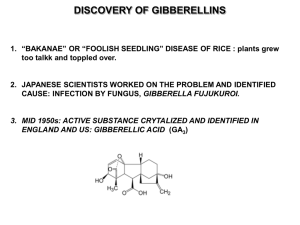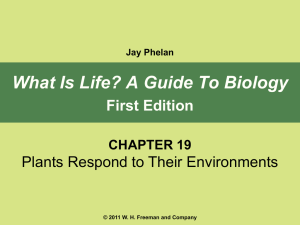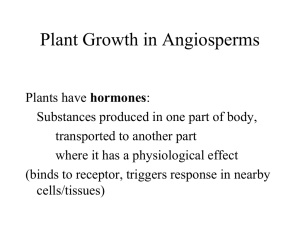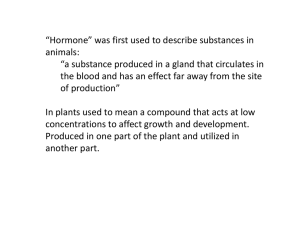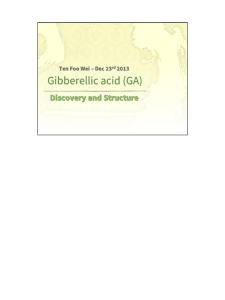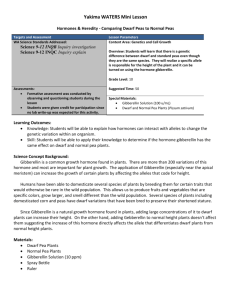Plant hormome handout
advertisement
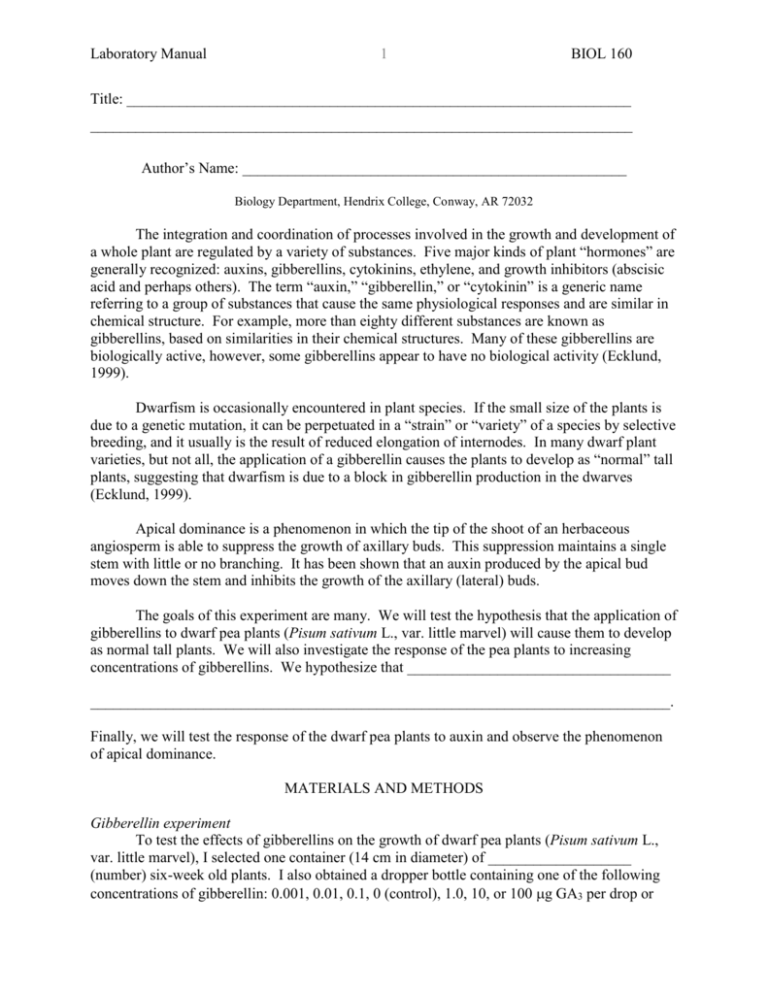
Laboratory Manual 1 BIOL 160 Title: ___________________________________________________________________ ________________________________________________________________________ Author’s Name: ___________________________________________________ Biology Department, Hendrix College, Conway, AR 72032 The integration and coordination of processes involved in the growth and development of a whole plant are regulated by a variety of substances. Five major kinds of plant “hormones” are generally recognized: auxins, gibberellins, cytokinins, ethylene, and growth inhibitors (abscisic acid and perhaps others). The term “auxin,” “gibberellin,” or “cytokinin” is a generic name referring to a group of substances that cause the same physiological responses and are similar in chemical structure. For example, more than eighty different substances are known as gibberellins, based on similarities in their chemical structures. Many of these gibberellins are biologically active, however, some gibberellins appear to have no biological activity (Ecklund, 1999). Dwarfism is occasionally encountered in plant species. If the small size of the plants is due to a genetic mutation, it can be perpetuated in a “strain” or “variety” of a species by selective breeding, and it usually is the result of reduced elongation of internodes. In many dwarf plant varieties, but not all, the application of a gibberellin causes the plants to develop as “normal” tall plants, suggesting that dwarfism is due to a block in gibberellin production in the dwarves (Ecklund, 1999). Apical dominance is a phenomenon in which the tip of the shoot of an herbaceous angiosperm is able to suppress the growth of axillary buds. This suppression maintains a single stem with little or no branching. It has been shown that an auxin produced by the apical bud moves down the stem and inhibits the growth of the axillary (lateral) buds. The goals of this experiment are many. We will test the hypothesis that the application of gibberellins to dwarf pea plants (Pisum sativum L., var. little marvel) will cause them to develop as normal tall plants. We will also investigate the response of the pea plants to increasing concentrations of gibberellins. We hypothesize that ___________________________________ _____________________________________________________________________________. Finally, we will test the response of the dwarf pea plants to auxin and observe the phenomenon of apical dominance. MATERIALS AND METHODS Gibberellin experiment To test the effects of gibberellins on the growth of dwarf pea plants (Pisum sativum L., var. little marvel), I selected one container (14 cm in diameter) of ___________________ (number) six-week old plants. I also obtained a dropper bottle containing one of the following concentrations of gibberellin: 0.001, 0.01, 0.1, 0 (control), 1.0, 10, or 100 g GA3 per drop or Laboratory Manual 2 BIOL 160 one of the unknowns: extract, extract diluted 1/10, or extract diluted 1/100. I then labeled the container of plants with my name, my lab day, and my chosen treatment. Before treating the plants with my gibberellin solution, I labeled all the plants in the container using flags of masking tape attached to toothpicks. Each plant was given a number such that it could be individually identified, and its associated flag was pushed into the dirt next to the plant. Then, the total numbers of visible nodes on each plant as well as each of their heights (initial stem length) were recorded. The height was measured between the top of the cotyledonary node and the top of the highest visible node. I then carefully separated the appressed stipules of the highest visible node of each plant and applied one drop of my gibberellin solution. I made sure that the drop was held between the two immature leaves, but if it fell off, I applied another drop. The plants were placed on a mobile growth cart and checked daily for water needs. The following week, I obtained my container of plants and again recorded the number of visible nodes and the height (final stem length) of each plant. I then calculated the percent change in stem length for all of the plants by subtracting the initial stem length from the final stem length, dividing this number by the initial stem length, and multiplying by 100% [(final stem length – initial stem length)/initial stem length x 100%]. A mean and standard deviation of percent change in stem length was calculated. I also calculated the number of nodes added for each plant and a mean and standard deviation for these data. Other investigators repeated the above procedures using different gibberellin concentrations (0.001, 0.01, 0.1, 0, 1.0, 10.0, and 100.0 g GA3 per drop or extract, extract 1/10, and extract 1/100). I gathered the mean percent (+/- 1 S.D.) changes in height and the mean number (+/- 1 S.D.) of nodes added from these investigators and combined them with my own. I then graphed the percent change in height vs. gibberellin (GA3) concentration on semilog graph paper, and using the graph, I estimated the concentrations of GA3 in each of the extracts. Auxin experiment To observe the phenomenon of apical dominance, I obtained two containers (14 cm in diameter), each with ___________________ (number) of six-week old dwarf pea plants (Pisum sativum L., var. little marvel). I labeled each container of plants with my name, my lab day, and either auxin or control, and labeled each plant in each pot with a number. To do so, I placed a masking tape-toothpick flag next to each plant. I cut a 1.5 x 1.5 cm square of aluminum foil for each plant in both tubs, except for two and created caps for the plants by centering each piece of aluminum foil over the top of a wooden dowel and folding down the edges. Leaving one plant in each container intact, I cut the tops off the other plants, just under the fourth node above the cotyledons. Using the broad end of a toothpick, I placed a glob of lanolin large enough to cover the cut surface on each of the cut plants in the control container. Similarly, I placed a glob of auxin (IAA) in lanolin on each of the cut plants in the auxin container. Each cut plant in both containers was then capped with a piece of aluminum foil. Lastly, the number of axillary buds that were greater than three millimeters in length on each plant was recorded. The plants were then placed on a growth cart and checked daily for water needs. The following week, I obtained the two containers of plants for the auxin experiment. I removed the aluminum foil caps and recorded the number of axillary buds greater than three millimeters in length on each plant. I calculated the total number of axillary buds greater than Laboratory Manual 3 BIOL 160 three millimeters in length for the control and the auxin tubs and compared these results to those of other investigators. RESULTS This section is to be completed and submitted at the next lab meeting. DISCUSSION This section is to be completed and submitted at the next lab meeting. LITERATURE CITED ECKLUND, PR. 1999. Chapter 17 – Angiosperm growth and development. In J.C. Glase and P.R. Ecklund [eds.], Investigative biology: a laboratory text, 311-334. Cornell Biology Department, Ithaca, New York, USA.
